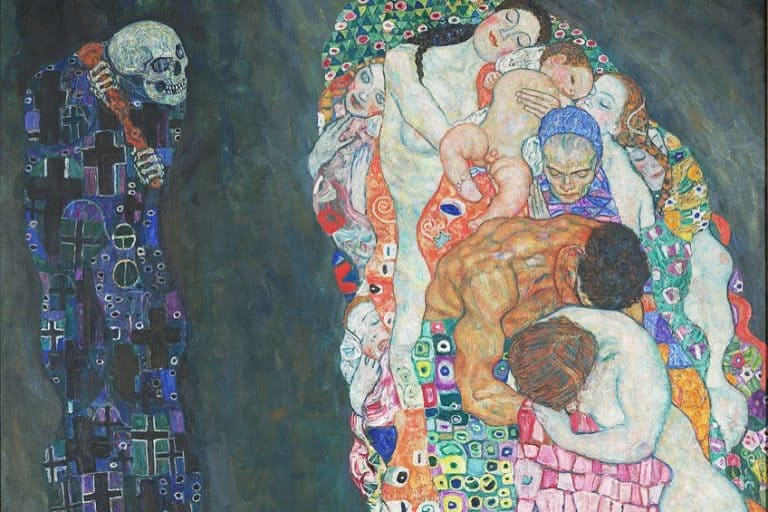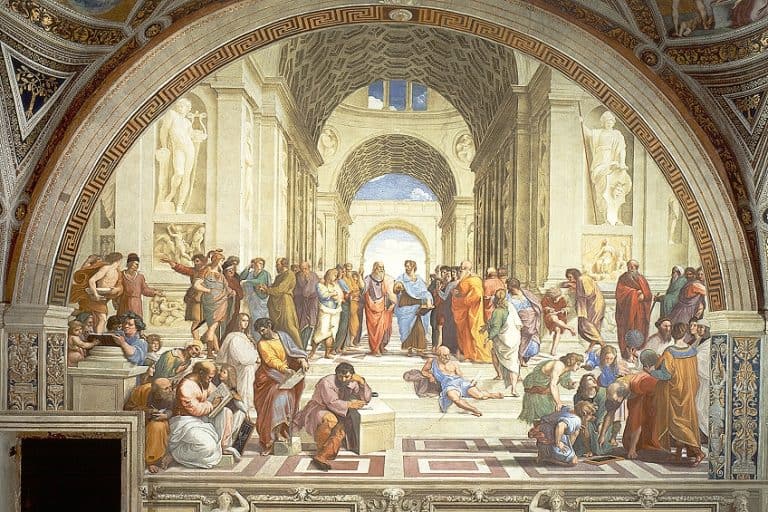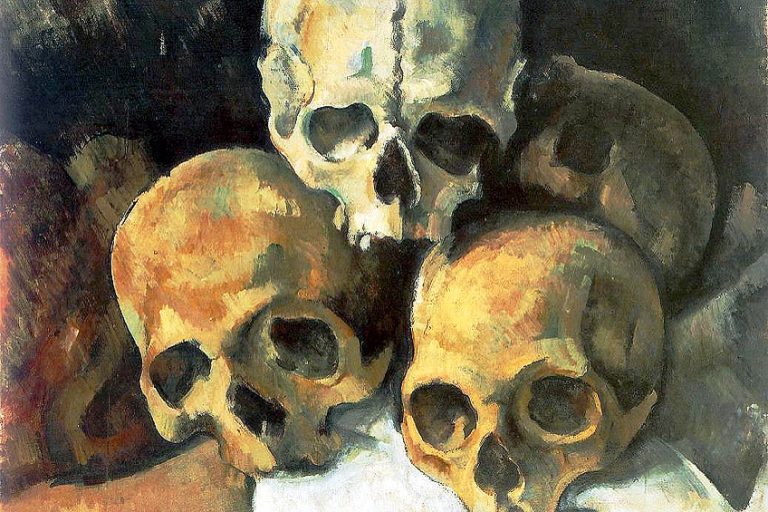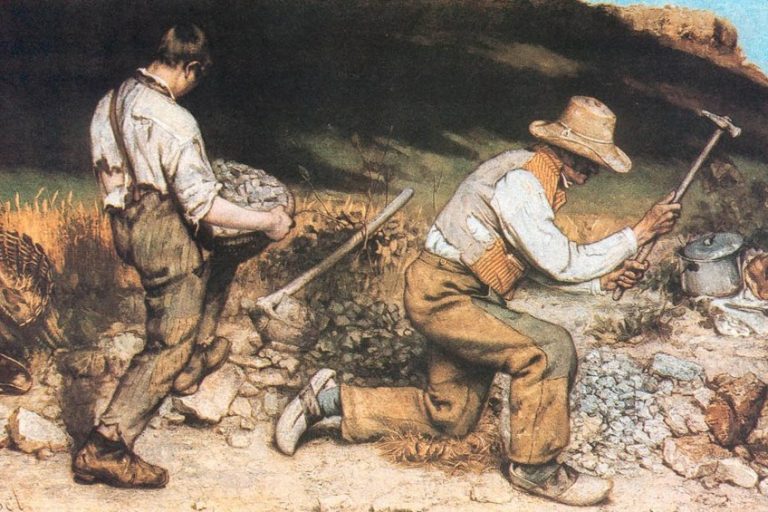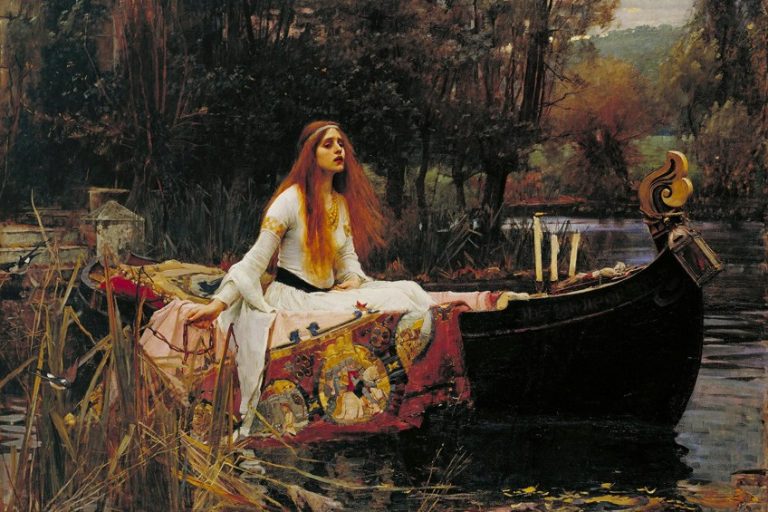Yves Klein Blue Painting – Analyzing This Blue Monochromatic Painting
Imagine the most brilliant blue color covering a canvas. Imagine standing in front of this canvas not knowing what to think of it or what meaning to make. What feelings are evoked? Is it like staring into a blue abyss, almost like the sky above or the deepest depths of the ocean below? These are some of the ideas we will touch on below from the famous blue painting collection of the French, or shall we say, blue painter, Yves Klein, who evidently was not blue himself.
Artist Abstract: Who Was Yves Klein?
Yves Klein was a French artist and martial artist, born on 28 April 1928 in the city of Nice, France. He came from a family with an artistic background, his mother was part of the Art Informel art movement, and his father was known to have a Post-Impressionist art style; Klein was also influenced by his aunt’s artistic style.
During the years of 1942 to 1946, he studied at two French institutes, being the École Nationale de la Marine Marchand and École Nationale des Langues. Klein also practiced Judo at the Kodokan Judo Institute in Japan, earning his 4th Dan Black Belt in 1953. He was famous for his trademark blue color known as the International Klein Blue style. When he was 34 years old, he died from a heart attack.
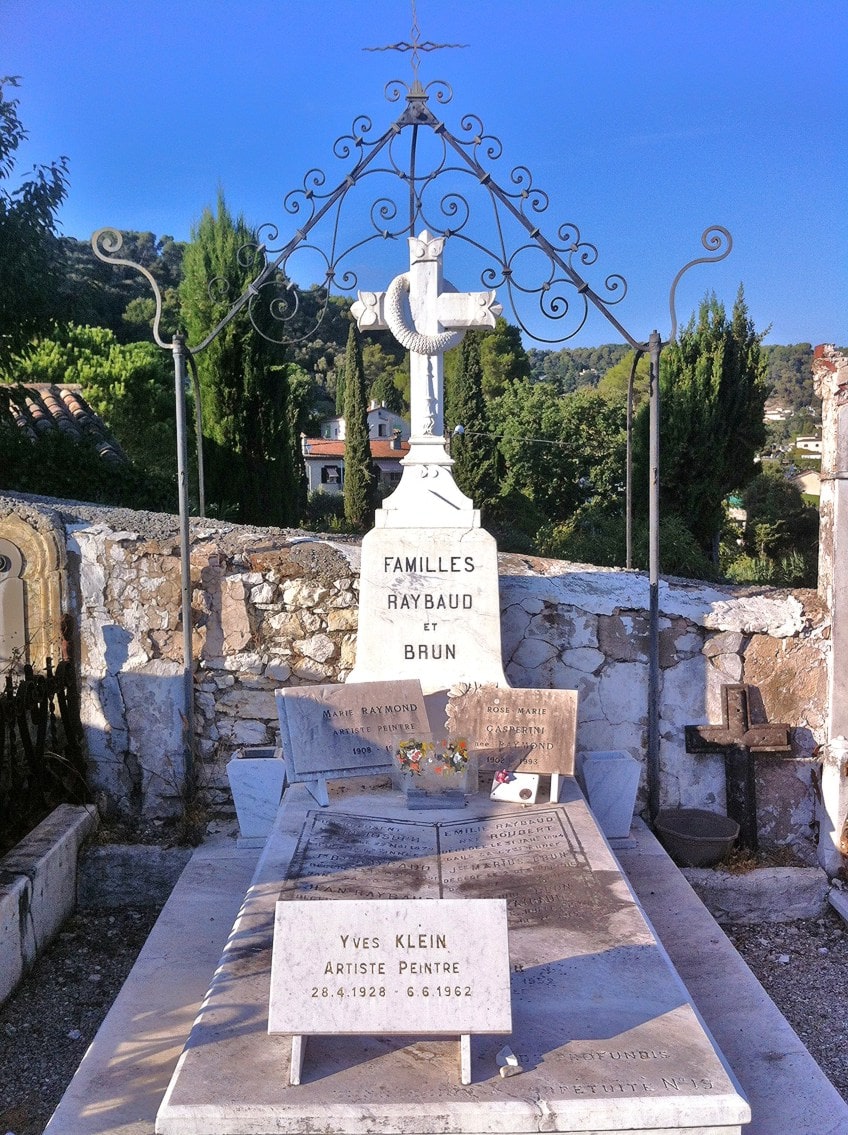
Yves Klein Blue Painting in Context
Yves Klein was famous for his blue monochromatic paintings, more specifically in the ultramarine blue color. The French artist was remembered as creating around 200 pieces, which resulted in his blue monochromatic painting collection. IKB, or International Klein Blue, is known as his trademark color style.
Below, we take a closer look at Yves Klein’s art and IKB, starting with a brief contextual background, where we will look at what motivated this blue painter to create the artworks he did.
Following this, we will look at a blue monochromatic painting example in more detail, giving a formal analysis of the subject matter, his stylistic processes, and other meanings related to the famous blue painting.
| Artist | Yves Klein |
| Date Painted | 1959 |
| Medium | Dry pigment in polyvinyl acetate on cotton over plywood |
| Genre | Painting, Performance |
| Period / Movement | Nouveau Réalisme and Performance art |
| Dimensions | 195.1 x 140 centimeters |
| Series / Versions | Part of the artist’s blue monochromatic paintings |
| Where Is It Housed? | Tate Modern, London, England |
| What It Is Worth | Not available |
Contextual Analysis: A Brief Socio-Historical Overview
Blue ran deep for Yves Klein, and he poured out this depth onto his canvases in the lustrous ultramarine we see on his canvases today. Let us look at the beginnings of Klein’s career, and more importantly, how he started painting his monochromes.
The year 1947 was an important marker for Klein because of an often reported “epiphany” he had while lying on the beach with his two friends. Yves Klein was good friends with Armand Fernandes, as well as Claude Pascal, who was a poet.
It was recalled that the three friends “divided” the universe into three, each being in control of one piece. Arman was in control of the earth, the physical world; Pascal was in control of “language and words”, and Klein was in control of space, or “the void” as it was called. This ultimately led to Klein’s interest in the ideas of space and the void, and what was understood as infinity.
From Multi-Color to Monochrome
Klein held private and public exhibitions during the 1950s and was remembered as starting with multi-colored paintings. His private exhibition from 1949 introduces us to his play on the monotone. The exhibition was called The Monotone-Silence Symphony, which consisted of playing 20 minutes of a musical chord and then 20 minutes of silence.
Klein continued to exhibit with multi-colored monochromes, his exhibition in 1955 was a public exhibition marked by his publication titled Yves Peintures (1954). Interestingly, Klein’s “booklet” was published before he produced the monochromatic paintings.
It consisted of ten colored sheets or “plates”, however, the booklet itself had around 15 pages. The sheets were rectangles of colors, such as yellow, red, brown, green, orange, gray, ultramarine blue, turquoise, pink, and light minty green. The first exhibition was held at the Club des Solitaires in October of 1955 and the second exhibition was held at the Gallery Colette Allendy in February 1956, which was called Yves: Proposition monochromes.
The above-mentioned exhibitions displayed monochrome paintings in various colors like reds, yellows, oranges, and blues.
However, the prominent colors were reportedly gold, blue, and pink for the Yves: Proposition monochromes exhibition. Gold and pink would specifically become significant signature colors for Klein alongside his famous blue.
Klein realized the effects the above exhibition had were undesired, especially in the way the audience saw it, which was more along the lines of being decorative pieces. The audience confused the Yves Klein art with a different type of “space”.
In other words, Klein aimed to convey a deeper meaning with his 20 paintings, one of an “immeasurable existence of color”, almost like infinite space, while the audience perceived it as more decorative-type pieces suited to indoor spaces.
The Beginnings of Blue
After his monochromes of different colors and the undesirable reception of these from his exhibition in 1956, Klein started with his newer monochromes, which consisted of only blue. In 1956 he created what was to become his trademark color called International Klein Blue with the assistance of Edouard Adam who was the owner of an art supply shop in Paris,
This led to his exhibition in 1957 called Proposte Monocrome, Epoca Blue, which means “Proposition Monochrome; Blue Epoch”, at the Milan-based Gallery Apollinaire. Here Klein displayed 10 blue paintings with even spaces between each. However, some sources state Klein displayed 11 paintings. The said “blue” paintings were held in place on poles and all appeared identical in shape.
What was unique about Klein’s new exhibition was that he gave each painting a different price, which further added to how each painting would be perceived even though they were all similar. This was done to ascertain the personalized perceptions of each painting on the viewer’s, or buyer’s, part, and the effects the paintings had on them and their own unique perception of value.
Klein continued utilizing and applying blue in different ways, most notably in his Anthropométries (“Anthropometry”) series, which included female models’ bodies and paint rollers. These were not typical exhibitions, but more performances where women were in the nude and covered with blue paint, and they made imprints on large canvases or walls with their bodies.
Accompanying the performance was live music played by several musicians. It has often been reported that the above-mentioned display of blue became a performance art and there were people who attended as audience members clad in formal attire.
What is worth noting here about the above-mentioned “performance” piece was that Klein approached his artwork in a wholly different manner. Whereas he was previously involved in the process of its creation, here he seemed to orchestrate his artwork intentionally, from afar.
He is reported as saying about his blue-painted models and artwork, “I personally would never attempt to smear paint over my own body and become a living brush; on the contrary, I would rather put on my tuxedo and wear white gloves. I would not even think of dirtying my hands with paint. Detached and distant, the work of art must complete itself before my eyes and under my command”.
Klein produced numerous other works during his artistic career and was remembered as one of the leading figures or pioneers of performance art.
He also experimented with different media that played with the idea of infinity, specifically the addition of more natural materials like gravel, fire, sea sponges, and water. He created sculptures that would convey a sense of the infinite, something that was quite significant to the artist and his inner world and perceptions.
Nouveau Réalisme
It is also important to note that Klein was a part of the Nouveau Réalisme group, which means “New Realism”. The Nouveau Réalisme group originated in France during the 1960s and was led by Pierre Restany who was an art critic and Yves Klein, the latter was an important leading figure. However, both figures had differences of opinions when it came to the group and what it stood for, whether it was following in the footsteps of Dadaism or something more postmodern.
The movement was known as the French equivalent of Pop Art and utilized a variety of artistic modalities as expression. The core tenets of the group were to utilize objects and deconstruct these to convey a message. Furthermore, it was to meld objects and make something new in line with a more realistic view of reality.
The group of artists had their first exhibition in Milan at the Apollinaire Gallery in 1960. This is also when Restany used the term Nouveau Réalisme to refer to and describe the artworks of various artists, including Klein. Restany wrote the following in the exhibition’s catalog, “The passionate adventure of the real perceived in itself and not through the prism of conceptual or imaginative transcription”.
Restany also wrote the manifesto for the group who signed their names in it, the manifesto read, “The Nouveaux Réalistes have become conscious of their collective identity; Nouveau Réalisme = new perceptions of the real”. Some of the notable artists included Arman, whose full name is Armand Pierre Fernandez, Jean Tinguely, Daniel Spoerri, Raymond Hains, François Dufrêne, and others.
Yves Klein eventually broke away from the group during 1961 due to the group’s close affinity for and continuation of the Dadaist legacy. Klein’s artwork became more progressive and veered away from the seeming limited aspects that the Nouveau Réalisme group held on to.
Formal Analysis: A Brief Compositional Overview
Below we will discuss several examples of Klein’s blue monochromatic painting pieces while focusing on a selected example throughout for more context. Although many appeared almost identical, Klein created a significant number of different blue pieces. Yves Klein art is characterized by only one element, and that is blue, more specifically his International Klein Blue, which is the primary subject matter for his famous blue painting collection.

Subject Matter: Blue Is the Main Protagonist Here
One example from the Yves Klein blue painting collection is IKB 79, Untitled Blue Monochrome (1959). Numerous paintings are titled “IKB”, which stands for International Klein Blue. After Klein’s death his wife, Rotraut Klein-Moquay, numbered the paintings in this manner, giving each painting a specific designating number as there were almost 200 blue monochromatic painting pieces.
However, the pieces were not numbered in the order they were made in and so there has been difficulty in determining the chronological order of each Klein blue painting.
In this example, we look at number 79, which, as we would surmise, is a monochromatic canvas painted completely in the trademark blue that Yves Klein is so famous for. There is nothing else on this canvas except the blue color, filling up each corner and border.
In IKB 79 we are almost forced to stop and stare for a while longer in case something might jump out at us from the blue depths. In fact, it is this blue depth that Klein makes the focal point in this composition, and some would question whether we can call this a composition at all, is it not just a canvas painted blue?
For Yves Klein the main subject matter is blue, this is the blue paint as the medium and the blue color and what it symbolizes.
Klein places this in front of us, the viewers, and whether we question it or not is up to us. Ultimately, he is evoking a new way of seeing, a new way of stopping and understanding something that is not depicted in a traditional and conventional manner, but uniquely avant-garde.
Color
We would be remiss if we did not have a part of the formal analysis discussing color, however, maybe we are all aware by now the primary color of the composition is blue. But what blue is this and how did Klein create his signature color and ultimately, his signature subject?
This Klein blue has been called an ultramarine hue, but the artist himself worked on the color with a chemist/scientist to achieve the unique color it is now.
The process consisted of “suspending” the dry blue pigment in a blend of synthetic resin, namely polyvinyl acetate, and a binder. The color also has a matte effect, which has been a large component of its unique vividness.
The Klein blue has been a trademarked color. Yves Klein presented a Soleau envelope in 1960 to patent his blue color, however, there has been debate about the accuracy of this as some scholarly sources suggest that Klein never patented his color; the submission of the Soleau envelope preceded the patent application process. It should be noted that there is a difference between the concepts of trademark and patent.
As we mentioned earlier, Klein exhibited with other colors with his signature blue, however, he would focus on pink and gold as the other important primary colors in his artistic palette. These colors represented different ideas to Klein. He is reported as saying about his exhibition Yves: Propositions Monochromes:
“Fire is blue, gold and pink, the bases of my monochrome paintings. I see it as a universal principle for the explanation of the world”.
An example of Klein’s pink and gold can be seen in his Ex-voto (1961), which was a dedication to Saint Rita of Cascia. This was given to the monastery of the same name. It is reported that Klein made several pilgrimages to this monastery and his artwork is a testament to his devotion to his religious beliefs. In Klein’s Ex-voto, we see the primary colors, pink on the far left his signature Klein blue in the middle, and to the far right what appears to be gold leaf. The colors are set in three squares on the top part.
Texture and Line
If we look at other examples from the Yves Klein blue painting collection, we will notice his play with different textures. Some of his paintings appear with thickly applied paint and others with thinner applications like in IKB 79.
For example, in IKB 45 (1960) we see the entire canvas covered in thick strands of dried paint, seemingly applied in all sorts of directions. If we look closer, we can easily reach out our hand and touch the thick protrusions of paint.
Another example is IKB 67 (1959) where we notice a uniform application of thinner brushstrokes, which have a slight relief to them. This Klein blue almost reminds us of the calming ocean waves rippling from a light breeze. Could this be one of the effects Klein wanted to convey?
In other examples Klein utilizes sponges to create a relief effect, this we see in Blue Sponge Relief (RE 51) (Relief Eponge Bleu) (1959) and Untitled Blue Sponge Relief (RE 18) (1960). The latter is another blue canvas, but in this example, we will notice almost over 20 small natural sponges in two large, centralized, clumped groups, with one or two towards the outer edges. Klein also included pebbles in some of these compositions, which played on the ideas of the infinite world and physical world.
There is an element of line when we look at some of Klein’s more textured blue paintings. Through the texture, a sense of formal line and geometry is created, but was this Klein’s intention or merely just a stylistic consequence of the effects created by how the paint was applied and dried?
For Klein, focusing on lines in a painting did not seem as important as his focus on the monochromatic space, which ultimately represented the idea of space and the infinite, something the artist could not convey using conventional formal elements in painting like lines, shapes, and structure.
The Symbolism of Blue
For Klein blue was something deeper than just applying a color to a canvas. The artist was a deep thinker, and we see this depth of feeling and awareness depicted on the canvas, we almost become consumed by it in our seeming uncertain consumption of it. Some of the symbolic references from this painting refer to something Klein felt an affinity to, which was the idea of infinity. For him, the monochrome was a reference to infinite space.
He is often quoted as comparing his paintings to being an “open window to freedom, as the possibility of being immersed in the immeasurable existence of color”.
Klein was also impacted by the beautiful blues from frescos in Italy, he held religious beliefs in the Catholic faith and blue was religiously symbolic. We see this blue in most of the Renaissance paintings especially the meaning it holds depicted on holy figures like Jesus Christ or Mother Mary.
Klein was not only religious but he was also learned in philosophical ideals, reportedly the Rosicrucian order, an esoteric spiritual movement that believes in wisdom passed down from ancient teachings or times. Klein was also familiar with the teachings of Buddhism, teachings he would have inevitably learned more in-depth during his stay in Japan when he learned martial arts, specifically Judo.
Furthermore, the International Klein Blue resembled the sky and depths of the ocean, the infinite expanses of these natural environments. We are urged to recall when Klein and his two friends lay on the beach and Klein was the keeper, so to say, of the sky or space, or as some say, “the void”.
Always Blue and Beyond
Yves Klein art is unique, and he was one of the pioneers of performance arts, not only painting but incorporating melodies as part of his performing pieces. The blue painter also painted objects blue, whether it was a cast of a globe of the earth, La Terre Bleue (1957), or a plaster of female nude representing Venus, La Vénus d’Alexandrie (Vénus Bleue) (1961).
Whether we call it the void or infinity, either concept holds the essence of something unseen, immaterial, immeasurable, and a world beyond what we understand. These concepts are brought to life in Yves Klein’s famous blue painting collection we touched upon in the article above.
To understand even a fraction of Yves Klein, the beloved blue painter, we need to merely gaze at his artwork. He has been described along the lines of being a mystic and alchemist and we see this in his oeuvre. He understood something deeper about life, which was undoubtedly developed by his experience in martial arts and his time living in Japan. Yves Klein died of a heart attack when he was 34 years old and since his death, he has been one of the widely celebrated artists from the 20th century. He is difficult to miss and easy to spot at any art gallery – just look out for the bluest blue you have ever seen.
Frequently Asked Questions
Who Was Yves Klein?
Yves Klein was a French painter who lived and painted during the mid-1900s. He was famous for his trademark color called International Klein Blue and his blue monochromatic painting style, which was on canvases as well as sculptural objects. He was a significant artist and one of the pioneers of performance art. He was part of the Nouveau Réalisme art group and paved the way for other art movements like Minimalism and Pop Art.
What Is IKB?
IKB, also known as International Klein Blue, is a color trademarked by the French artist from the 1900s, Yves Klein. This is an ultramarine blue that Yves Klein formulated by “suspending” dry pigment in a binding solution. The effect produced was of a brilliant blue hue.
What Was the Meaning Yves Klein Blue?
Blue symbolized different things for Yves Klein, namely, religious meanings inspired by the blues from religious paintings typical of the Renaissance period. Klein also believed deeply in conveying the ideas of infinity and space, “the void”. His paintings became representations of the “immeasurable” aspects of infinity. Furthermore, Yves Klein’s paintings also represent the vastness we find in the sky and the ocean.
What Type of Artist Was Yves Klein?
Yves Klein was a painter and sculptor; however, he was one of the first artists who started performance arts and developed it further. He was also known as one of the first conceptual artists from the 20th century due to various of his performed pieces. For example, what is known as his photomontage of jumping from a building to appear like he was flying, called Saut dans le vide (Leap into the Void) (1960). Other examples include exhibiting invisible artworks in a gallery space as “seen” in his exhibition called The Void (1958), which was held at the Iris Clert Gallery located in Paris. All that was in this gallery space was an empty cabinet, a window painted blue, and a blue curtain for the entrance. Klein organized this exhibition like a real event, providing blue drinks for the guests who were reportedly around 3,000 in number.
Isabella studied at the University of Cape Town in South Africa and graduated with a Bachelor of Arts majoring in English Literature & Language and Psychology. Throughout her undergraduate years, she took Art History as an additional subject and absolutely loved it. Building on from her art history knowledge that began in high school, art has always been a particular area of fascination for her. From learning about artworks previously unknown to her, or sharpening her existing understanding of specific works, the ability to continue learning within this interesting sphere excites her greatly.
Her focal points of interest in art history encompass profiling specific artists and art movements, as it is these areas where she is able to really dig deep into the rich narrative of the art world. Additionally, she particularly enjoys exploring the different artistic styles of the 20th century, as well as the important impact that female artists have had on the development of art history.
Learn more about Isabella Meyer and the Art in Context Team.
Cite this Article
Isabella, Meyer, “Yves Klein Blue Painting – Analyzing This Blue Monochromatic Painting.” Art in Context. January 20, 2022. URL: https://artincontext.org/yves-klein-blue-painting/
Meyer, I. (2022, 20 January). Yves Klein Blue Painting – Analyzing This Blue Monochromatic Painting. Art in Context. https://artincontext.org/yves-klein-blue-painting/
Meyer, Isabella. “Yves Klein Blue Painting – Analyzing This Blue Monochromatic Painting.” Art in Context, January 20, 2022. https://artincontext.org/yves-klein-blue-painting/.





